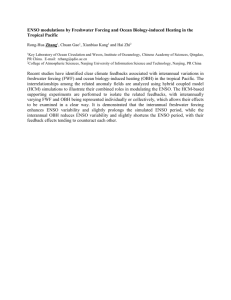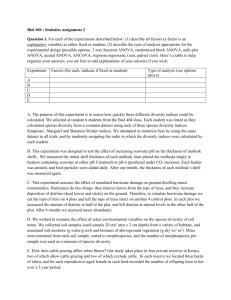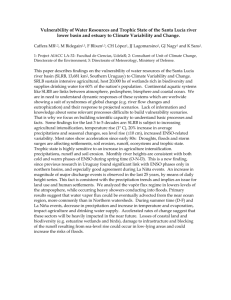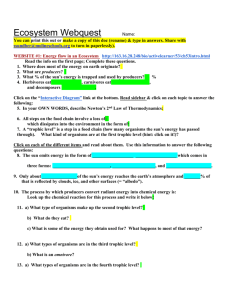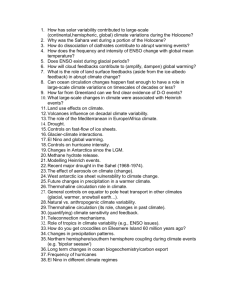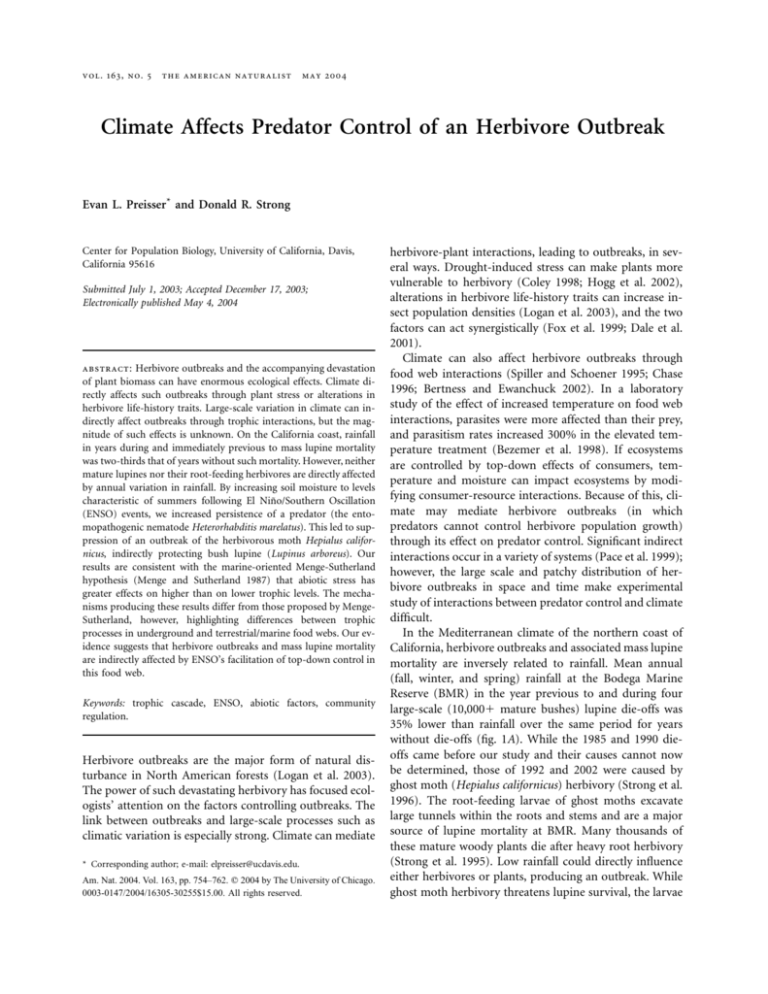
vol. 163, no. 5
the american naturalist
may 2004
Climate Affects Predator Control of an Herbivore Outbreak
Evan L. Preisser* and Donald R. Strong
Center for Population Biology, University of California, Davis,
California 95616
Submitted July 1, 2003; Accepted December 17, 2003;
Electronically published May 4, 2004
abstract: Herbivore outbreaks and the accompanying devastation
of plant biomass can have enormous ecological effects. Climate directly affects such outbreaks through plant stress or alterations in
herbivore life-history traits. Large-scale variation in climate can indirectly affect outbreaks through trophic interactions, but the magnitude of such effects is unknown. On the California coast, rainfall
in years during and immediately previous to mass lupine mortality
was two-thirds that of years without such mortality. However, neither
mature lupines nor their root-feeding herbivores are directly affected
by annual variation in rainfall. By increasing soil moisture to levels
characteristic of summers following El Niño/Southern Oscillation
(ENSO) events, we increased persistence of a predator (the entomopathogenic nematode Heterorhabditis marelatus). This led to suppression of an outbreak of the herbivorous moth Hepialus californicus, indirectly protecting bush lupine (Lupinus arboreus). Our
results are consistent with the marine-oriented Menge-Sutherland
hypothesis (Menge and Sutherland 1987) that abiotic stress has
greater effects on higher than on lower trophic levels. The mechanisms producing these results differ from those proposed by MengeSutherland, however, highlighting differences between trophic
processes in underground and terrestrial/marine food webs. Our evidence suggests that herbivore outbreaks and mass lupine mortality
are indirectly affected by ENSO’s facilitation of top-down control in
this food web.
Keywords: trophic cascade, ENSO, abiotic factors, community
regulation.
Herbivore outbreaks are the major form of natural disturbance in North American forests (Logan et al. 2003).
The power of such devastating herbivory has focused ecologists’ attention on the factors controlling outbreaks. The
link between outbreaks and large-scale processes such as
climatic variation is especially strong. Climate can mediate
* Corresponding author; e-mail: elpreisser@ucdavis.edu.
Am. Nat. 2004. Vol. 163, pp. 754–762. 䉷 2004 by The University of Chicago.
0003-0147/2004/16305-30255$15.00. All rights reserved.
herbivore-plant interactions, leading to outbreaks, in several ways. Drought-induced stress can make plants more
vulnerable to herbivory (Coley 1998; Hogg et al. 2002),
alterations in herbivore life-history traits can increase insect population densities (Logan et al. 2003), and the two
factors can act synergistically (Fox et al. 1999; Dale et al.
2001).
Climate can also affect herbivore outbreaks through
food web interactions (Spiller and Schoener 1995; Chase
1996; Bertness and Ewanchuck 2002). In a laboratory
study of the effect of increased temperature on food web
interactions, parasites were more affected than their prey,
and parasitism rates increased 300% in the elevated temperature treatment (Bezemer et al. 1998). If ecosystems
are controlled by top-down effects of consumers, temperature and moisture can impact ecosystems by modifying consumer-resource interactions. Because of this, climate may mediate herbivore outbreaks (in which
predators cannot control herbivore population growth)
through its effect on predator control. Significant indirect
interactions occur in a variety of systems (Pace et al. 1999);
however, the large scale and patchy distribution of herbivore outbreaks in space and time make experimental
study of interactions between predator control and climate
difficult.
In the Mediterranean climate of the northern coast of
California, herbivore outbreaks and associated mass lupine
mortality are inversely related to rainfall. Mean annual
(fall, winter, and spring) rainfall at the Bodega Marine
Reserve (BMR) in the year previous to and during four
large-scale (10,000⫹ mature bushes) lupine die-offs was
35% lower than rainfall over the same period for years
without die-offs (fig. 1A). While the 1985 and 1990 dieoffs came before our study and their causes cannot now
be determined, those of 1992 and 2002 were caused by
ghost moth (Hepialus californicus) herbivory (Strong et al.
1996). The root-feeding larvae of ghost moths excavate
large tunnels within the roots and stems and are a major
source of lupine mortality at BMR. Many thousands of
these mature woody plants die after heavy root herbivory
(Strong et al. 1995). Low rainfall could directly influence
either herbivores or plants, producing an outbreak. While
ghost moth herbivory threatens lupine survival, the larvae
Abiotic Control of a Trophic Cascade 755
Figure 1: A, Mean 1980–2002 July–June rainfall in Bodega Bay, California, preceding and during years (n p 4 ) in which there was large-scale
(10,000⫹ mature bushes) lupine damage versus years in which no large-scale mortality occurred (n p 19 ; mean Ⳳ SE ; means differ at P ! .050;
F p 4.33, df p 1, 21). Lupine data for 1985, 1990, and 1992 from Strong et al. (1995). B, Mean 1969–2002 July–June rainfall at Bodega Marine
Reserve during consensus non-ENSO (including La Niña events; n p 23 ) and ENSO (n p 11 ) climatic events. Means differ at P ! .040 (F p
4.61, df p 1, 32). Consensus data on ENSO events gathered from list maintained at http://ggweather.com/enso/years.htm. This consensus list is
based on records maintained by the Western Region Climate Center, Climate Diagnostics Center, Climate Prediction Center, and the Multivariate
ENSO Index from the Climate Diagnostics Center. A consensus event occurs when three or more of the four records agree as to the classification
of a year as ENSO or non-ENSO.
themselves are prey for the entomopathogenic nematode
Heterorhabditis marelatus. While both correlational
(Strong et al. 1996) and experimental (Strong et al. 1999;
Preisser 2003) evidence suggests that H. marelatus can regulate ghost moth populations, the nematode’s dependence
on soil moisture to facilitate movement and prevent desiccation (Grant and Villani 2003) may make it sensitive
to climatic fluctuations. If unusually dry conditions lessen
the nematode’s control over ghost moth populations, leading to an outbreak, then heavy winter and spring rains
may be more suitable for predator persistence and herbivore control.
In 2002, fortuitous circumstance provided us a means
of experimentally discriminating between direct and indirect climatic control of ghost moth outbreaks. On the
northern coast of California, heavy winter and spring rains
are associated with El Niño/Southern Oscillation (ENSO)
events, and intervening years are much dryer (fig. 1B). As
is typical with large-scale climatic events, the correlation
between ENSO and increased rainfall may vary locally. The
1992 outbreak, for example, occurred during an ENSO
year with below-average rainfall at BMR (1992: 66.7 cm;
1969–2002 mean Ⳳ SE: 85.4 Ⳳ 5.9 cm). On average, however, large-scale herbivore outbreaks at BMR occur during
successive years of below-average rainfall (fig. 1A), and
ENSO years at BMR are characterized by above-average
rainfall (fig. 1B). In 2001, a dry, non-ENSO year, we experimentally elevated summer soil moisture and measured
the effect of predator presence and soil moisture on the
nematode/ghost moth/lupine cascade (Strong 1997; Strong
et al. 1999; Preisser 2003). The predator treatment tested
the nematode’s capacity to indirectly affect lupines via their
effect on ghost moth density. The summer watering treatment (hereafter referred to as ENSO) tested whether higher
rainfall affected each of the species in the food web. The
interaction of the two treatments tested whether the predator’s impact was affected by variation in soil moisture. If
either lupines or their ghost moth herbivores are directly
affected by soil moisture, their response to watering should
be independent of predator presence. If their response is
the indirect result of soil moisture effects on the nematode
predator, however, then only organisms in the predator
treatment should respond to increased soil moisture.
Material and Methods
The experiment reported in this article is the same as the
one described by Preisser (2003) but presents new data
from the second year of the experiment (in which an unexpected herbivore outbreak occurred) while analyzing the
experiment for the effects of supplemental watering. We
simulated the soil moisture conditions of summers following heavy winter/spring rains produced by ENSO climatic events with watering. Our experiment began in winter 2001 in the coastal grasslands of BMR as a two-factor
crossed design: predator (the nematode Heterorhabditis
756
The American Naturalist
marelatus added) or no predator versus ENSO (supplemental water added twice weekly) or ambient (no water
added). While this treatment simulates aspects of an ENSO
year, it is not an exact simulation since we did not provide
higher winter rainfall. We applied four experimental treatments (predator/ENSO, predator/ambient, no predator/
ENSO, no predator/ambient) to eight plots divided into
two 20 # 13-m contiguous blocks of mixed lupine
grassland.
There were two replicate plots in each of the four treatments, with each plot representing the mean response of
10 lupine bushes. Preliminary surveys of lupine in the area
revealed very low ghost moth (Hepialus californicus) densities (mean of one larvae/bush) and a low incidence of
H. marelatus (one out of 140 bushes surveyed). We selected
10 mature lupines/plot with comparable stem diameters
(mean Ⳳ SE: 3.79 Ⳳ 0.068 cm), no detectable H. marelatus, and no visible ghost moth damage. To mitigate effects of intraspecific competition, lupines in contact with
experimental bushes were removed. In spring 2001, we
added H. marelatus using four nematode-infected waxworm (Galleria mellonella) cadavers/bush in a mesh cage
through which nematodes escaped (to prevent animals
from removing them) and burying the cage at the base of
each lupine in the predator treatment. To control for any
effects of disturbance, we used the same procedure to add
cold-killed waxworms to each lupine in the no predator
treatment. Heterorhabditis marelatus is polyphagous (Cottrell et al. 2001) and can prey on ground-dwelling herbivorous and detritivorous insect larvae. Aluminum flashing (4 cm aboveground and 10 cm belowground) fenced
off each plot to prevent H. marelatus movement.
One week after nematode addition, we added 24 second
to third instar ghost moth larvae to the soil at the base of
each experimental lupine. We chose these instars to maximize the chance that some caterpillars would survive the
transition onto the lupine root. This number of larvae is
within the range of natural densities previously recorded
at BMR (Strong et al. 1995). We did not prevent natural
ghost moth oviposition, since doing so might have interfered with pollinators, predators, and/or the underground
food web. The larvae were raised from eggs collected by
capturing mated ghost moth pairs at BMR in winter 2001.
Previous to their release, they were fed sliced carrots, a
standard culture technique for ghost moth larvae (Wagner
1985) that produces caterpillars of approximately the same
size as those fed lupine roots. We repeated the addition
of 24 second to third instar H. californicus larvae in spring
2002.
ENSO Treatment
We calibrated a drip irrigation system to produce conditions of increased summer soil moisture in our ENSO
treatment. Water was added to lupines in the ENSO treatment during the dry season (April–November) using the
drip irrigation system operating 2 h/d twice a week.
Testing the Accuracy of the ENSO Treatment
To evaluate whether our ENSO treatment satisfactorily reproduced the levels of summer soil moisture expected following ENSO events, we tested for a relationship between
summer (July–August) soil moisture and winter/spring
(September–June) rainfall by collating data on mean summer soil moistures under lupines in coastal prairies. We
gathered data for summer 1973 (BMR; Davidson 1975),
1985, and 1986 (Año Nuevo State Reserve, Calif.; Alpert
and Mooney 1996) and collected data from 2001 and 2002
(BMR). For each soil moisture mean, we determined winter/spring rainfall using the nearest rainfall gauge.
Data Collection
We assessed predator (H. marelatus) persistence in lupine
(Lupinus arboreus) rhizospheres by collecting soil in a plastic container from underneath each lupine on October 25,
2002, and wetting it with distilled water to approximately
30 mg H2O/g dry soil. Six G. mellonella larvae were added
to each soil container as bait for the nematode. After 1
wk, predation by H. marelatus was assessed visually using
the distinctive orange color of nematode-killed cadavers.
Using these data, the soil sample from each lupine was
scored either positive (one or more nematode-killed cadavers) or negative (no nematode-killed cadavers) for the
presence of H. marelatus.
We measured ghost moth larval abundance on August
15, 2002, using counts of frass extrusions from their larval
galleries (Mo and Tanton 1995). There is an approximately
1 : 1 correlation between the number of frass extrusions/
root and larvae/root (J. Havstad, E. L. Preisser, and D. R.
Strong, unpublished data).
We measured lupine trunk diameter at ground level on
September 19, 2001 (the end of the first year of the experiment), and September 15, 2002 (end of the second
year of the experiment). Diameter data were used to calculate basal area, log transformed, and lupine trunk diameter growth expressed as ln (basal area)end of second year ⫺
ln (basal area)end of first year.
Seedset/lupine was determined on July 29, 2002, by
counting all seedpods on experimental lupines and then
multiplying by the average seeds/pod (the mean of 20
haphazardly gathered seed pods/bush) to determine total
seedset/bush. On July 16, 2001, and August 13, 2002, we
sampled soil moisture by collecting soil under all experimental lupines and determining its percent H2O/g dry
soil. This was done by collecting 100 g of soil from 0–5
Abiotic Control of a Trophic Cascade 757
cm deep at the trunk-soil interface of each experimental
lupine, immediately weighing it, then reweighing it after
drying it at 60⬚C for 2 d.
Statistical Analysis
Experimental data were analyzed using a two-way ANOVA
(predator # ENSO). When necessary, data were square
root transformed before analysis to meet the assumption
of normality. The analyses tested for the main effects predator, ENSO, and the predator # ENSO interaction. Each
ANOVA also included block to test for site-specific differences; if not significant (P ! .05), the term was removed
and the analyses rerun. If the predator # ENSO interaction was significant in an analysis, we compared treatment
means using Student’s t-test. Planned contrasts between
the no predator/ENSO and no predator/ambient treatments were used to examine the direct effect of the ENSO
treatment.
Rainfall data were analyzed using one-way ANOVA. In
the analysis of rainfall during and immediately preceding
lupine mass mortality, the one-way ANOVA used die-off;
in the analysis of rainfall during ENSO events, the ANOVA
used ENSO.
Linear regression was used in the analysis of winter/
spring (September–June) rainfall versus the following
summer’s (July–August) mean soil moisture/lupine (measured in mL H2O/g dry soil). All data were analyzed using
JMP version 4.03 (SAS Institute 2001).
Results
ENSO Treatment
Mean summer soil moisture in lupine rhizospheres was
strongly related to winter/spring rainfall (F p 24.30,
df p 1, 3, P ! .016; r 2 p 0.89; soil moisture [mL H2O/g
dry soil] p 0.103 # rainfall [cm] ⫺ 2.64). We calculated
with this regression formula the range of summer soil
moistures expected at BMR during ENSO events on the
basis of rainfall records from 1969 to 2002 and a list
of consensus ENSO years maintained by http://
ggweather.com/enso/years.htm. Soil moisture in lupine
rhizospheres in the ENSO treatment (sampled in summer
2001) was higher than that found in summer 2001 and
2002 at BMR and within the range predicted under lupine
bushes in summers following an ENSO event at BMR
(treatment 4 h postwatering [mean response of four
plots Ⳳ SE]: 0.137 Ⳳ 0.002 mL H2O/g dry soil; treatment
2 d postwatering: 0.086 Ⳳ 0.004; predicted range of summer soil moisture following an ENSO event: 0.066–0.093).
Experimental Results
In the first year of the experiment (2001), we discovered
powerful top-down control in this system, with predators
decreasing herbivore density and increasing lupine growth
and seedset (Preisser 2003). We restocked ghost moth larvae but not nematodes the second year. Our decision not
to restock nematodes during 2002 ensured that the only
nematode predators present in the second year of the experiment were those populations that had either persisted
or immigrated into the experimental rhizospheres.
The ENSO summer watering treatment did not directly
affect herbivore density, lupine growth, or lupine seedset
in 2001 or 2002. Planned contrasts between the no predator/ENSO and no predator/ambient treatments revealed
no direct effect of increased soil moisture on either herbivores or mature lupines (F p 0.740 for herbivores,
F p 1.073 for lupines, df p 1, 3, all P 1 .05). Since Hepialus californicus larvae enter lupine roots in the second to
third instars and leave as adults (Wagner 1985), their direct
exposure to soil is minimal. The lupine’s lack of response
is understandable in light of their physiology. While lupine
seedlings are sensitive to water stress, mature lupines have
deep taproots several meters in length that reach into the
water table (Davidson 1975). The growth of mature lupines is thus largely buffered against seasonal moisture
variation in the upper soil horizons.
A ghost moth outbreak occurred in the spring/summer
of 2002 during a second consecutive year of unusually low
rainfall. Caterpillar densities at BMR increased 16-fold
to (mean Ⳳ SE) 9.84 Ⳳ 1.12 larvae/root in 2002 from
0.6 Ⳳ 0.6 larvae/root in 2001. In our plots, caterpillar density doubled between 2001 and 2002 (larvae/root across
all treatments, 2001: 3.18 Ⳳ 0.43; 2002: 6.58 Ⳳ 0.73). This
provided the opportunity to test whether climate-induced
variation in abiotic stress could indirectly control a naturally occurring herbivore outbreak.
The higher soil moisture in the ENSO treatment increased nematode persistence approximately ninefold in
lupine rhizospheres into the second year relative to the
ambient treatment (fig. 2A). Nematodes were detected
during 2002 in 19 out of 20 ENSO predator rhizospheres
versus only two out of 20 ambient predator rhizospheres
(predator # ENSO interaction: F p 29.02, df p 1, 3,
P ! .013). Nematodes decreased herbivore density by 42%
in predator/ENSO plots over the average of the other treatments (fig. 2B; predator # ENSO interaction: F p 11.42,
df p 1, 3, P ! .043).
The indirect effect of nematode predation on lupine
performance during the outbreak was substantial. Lupine
trunk diameter growth in the second year of the experiment increased 84% in the predator/ENSO treatment versus the average of the other three treatments, a marginally
758
The American Naturalist
Figure 2: Effect of experimental treatments in 2002 on (A) nematode persistence, (B) ghost moth presence, (C) lupine trunk diameter growth, and
(D) lupine seedset. Bars represent the mean of two plots/treatment taken from 10 lupine bushes/plot, and error bars are ⳲSE of the plot means.
Lowercase letters indicate statistically different means, P ! .05 (Student’s t-test).
significant difference (predator # ENSO interaction:
F p 8.50, df p 1, 3, P ! .062). Pairwise treatment comparisons of mean lupine growth revealed that the predator/
ENSO treatment differed significantly from the other three
treatments (fig. 2C). Similarly, lupine seedset increased
44% over the average of the other three treatments, showing that nematode presence increased plant fitness in
the presence of ENSO levels of summer soil moisture
Abiotic Control of a Trophic Cascade 759
(predator # ENSO interaction: F p 89.3, df p 1, 2, P !
.01; fig 2D).
Discussion
Soil moisture indirectly increased lupine (Lupinus arboreus) growth and seedset by fostering the predatory nematode Heterorhabditis marelatus, which suppressed the herbivorous ghost moth Hepialus californicus in the predator/
ENSO treatment. The effect of ENSO-induced variation
in soil moisture on this trophic cascade is striking. The
predator is greatly affected by soil moisture, relying on the
film of moisture surrounding soil particles for movement
and to resist desiccation (Grant and Villani 2003). In the
first year, nematodes suppressed herbivores in both the
ENSO and ambient treatments (Preisser 2003). Rainfall in
both 2001 and 2002 was unusually low, however, and by
2002, the nematode populations in the predator/ambient
treatment were largely extirpated (fig. 2A). In contrast,
nematodes persisted in 19 out of 20 watered lupine rhizospheres. This produced a trophic cascade in the predator/ENSO treatment during the 2002 herbivore outbreak,
where nematodes suppressed ghost moths and indirectly
benefited lupine bushes.
The differences between the 2 yr of the experiment are
evident in the data on lupine growth. In 2001, there was
no significant ENSO effect, and the relative growth of
bushes in the predator treatment was 67% higher than no
predator bushes (Preisser 2003). Between 2001 and 2002,
however, the basal trunk area growth of bushes in the
predator/ENSO treatment was twice that of the bushes in
the predator/ambient treatment and 84% higher than the
average of all three other treatments. The fact that the
predator/ambient treatment was indistinguishable from
the no predator treatments in the second year, 2001–2002,
indicates that any benefit of nematode presence under
ambient soil moisture conditions did not carry over into
the second year. Data from the first year of this experiment
showed an overall effect of predator presence on lupine
growth within 2 mo (Preisser 2003). The fact that lupine
growth during the second year (September 2001 to September 2002) showed no similar overall effect suggests that
the impact of predator addition in the predator/ambient
treatment was rapid but short-lived, dissipating by the end
of the first year.
Climate cycles such as ENSO can strongly influence food
web dynamics (Stenseth et al. 2002). An ENSO shift in
ocean currents affects climate on a continent-wide basis;
in northern California, ENSO produces heavy winter and
spring rains (fig. 1B). Summer soil moistures under lupines
are correlated with winter/spring rainfall; our ENSO treatment falls within the predicted soil moisture range following ENSO events (see “Material and Methods”). The
cascade thus varies with climate, providing winter and
spring protection for lupines most years interspersed with
year-round protection following years with high winter/
spring rainfall. Conversely, several unusually dry years (in
our case, two successive years of below-average rainfall)
can greatly reduce or extirpate nematode populations in
lupine rhizospheres. This releases the root-feeding herbivores from top-down control. Mean rainfall in the 3 yr
before an herbivore outbreak (with the herbivore outbreak
occurring in the third year) was marginally (P ! .06) below
average, suggesting an accumulating effect of abiotic stress
over periods of several years. It should be noted that the
correlation between ENSO and high yearly rainfall exists
over a large spatial scale and may be subject to local variation. An example of this was the 1992 outbreak, which
occurred during an ENSO year in which the rainfall at
BMR was below average (1992: 66.7 cm; 1969–2002
mean Ⳳ SE: 85.4 Ⳳ 5.9 cm). Thus, not all outbreaks occur
during non-ENSO years; similarly, not all non-ENSO winters were followed by outbreaks. On average, however,
large-scale herbivore outbreaks at BMR occur during successive years of below-average rainfall (fig. 1A), and ENSO
years at BMR are characterized by above-average rainfall
(fig. 1B). Wetter years generally prevent outbreaks, making
ENSO conditions a good (but not perfect) predictor of
nonoutbreak years. In other systems, ENSO has been
linked to fluctuations in herbivore populations (Todd et
al. 2002); at BMR, top-down effects on lupines are influenced by ENSO events affecting the nematode predator.
Our research supports the hypothesis that climate indirectly affects herbivore outbreaks and plant performance
through tritrophic interactions.
Weather, especially in the form of rainfall, can affect
terrestrial biotic interactions (Stenseth et al. 2002). Direct
(interference) and indirect competition between lizards for
resources occurred only during dry years (Dunham 1980),
and the effect of predatory lizards on spiders was positively
related to rainfall (Spiller and Schoener 1995). Less is
known about the impact of abiotic stress on indirect terrestrial food web interactions. The ecosystem exploitation
hypothesis (Fretwell 1977; Oksanen et al. 1981) addresses
how these interactions might change across a productivity
gradient but does not explicitly link productivity to abiotic
factors. Several empirical studies have shown that temperature affects grassland trophic cascades through its effect on herbivore feeding rates (Chase 1996; Ritchie 2000);
other studies have found that seasonality (Dawes-Gromadzki 2002; Norrdahl et al. 2002) and elevation (Preszler
and Boecklen 1996) affect indirect food web interactions.
Effects of abiotic stress on multitrophic interactions
have long been considered in both aquatic (freshwater;
Power 1990; Hill et al. 2001) and marine (Dayton 1971;
Connell 1975) systems. In their model of community reg-
760
The American Naturalist
ulation, Menge and Sutherland (1976, 1987) proposed that
abiotic stress affects higher trophic levels more strongly
than basal species. In the Menge-Sutherland model, consumers are mobile and can avoid stress, while organisms
farther down the food chain are increasingly sessile and
less able to shift between environments. Increasing environmental stress causes organisms on upper trophic levels
to abandon harsh environments, leaving only a two-level
(or, in extreme cases, one-level) food web. While the
Menge-Sutherland model addressed both terrestrial and
benthic food webs, support for its conclusions has emerged
predominantly from marine systems (Menge et al. 2002;
but see Polis and Strong 1996).
The results of our experiment provide experimental support for the Menge-Sutherland model in an underground
food web. The abiotic stress of low summer soil moisture
most affected the nematode predator, with no direct effect
on either ghost moth larvae or lupines. Interestingly, this
result is produced by a different mechanism than the one
hypothesized by Menge-Sutherland. In our case, small and
relatively sessile nematodes were unable to avoid abiotic
stress, and the unusually low rainfall during 2001 and 2002
prevented immigration and the recolonization of extirpated rhizospheres. In fact, the predator was the only
trophic level affected by environmental stress; neither mature lupines nor herbivores were directly affected by soil
drying. This result suggests that the cascade’s strength
should wax during the wet winter months and wane during
the dry summer and that this is due to the nematode’s
ability to deal with abiotic stress. Unusual climatic events
like ENSO may affect these broad seasonal patterns, facilitating top-down control throughout the year. Several
recent analyses of trophic cascades found no significant
effect of experimental duration on the cascade strength
(Shurin et al. 2002; Bell et al. 2003); however, it is clear
that seasonal changes can profoundly affect terrestrial food
web interactions (Gratton and Denno 2003).
The contradiction between the mechanisms driving
Menge-Sutherland dynamics and those in our system may
be related to differences in food web structure. The MengeSutherland model posits that higher trophic level organisms are, on average, large and mobile; in this system, the
nematode predator is 100- to 1,000-fold smaller than its
ghost moth prey, and adult moths are far more mobile
than nematodes. The Menge-Sutherland model correctly
predicts that the larger, more mobile organisms in our
food web suffer less mortality due to abiotic stress (see
also Spiller et al. 1998); in this case, the relationship between size, mobility, and trophic level is reversed. Underground food webs are often characterized by intraguild
predation, sometimes supporting five to 10 trophic levels
of similarly sized, relatively immobile organisms (Polis
1991; De Ruiter et al. 1995). The lack of predictable dif-
ferentiation by trophic level makes predictions about the
effects of abiotic stress on underground food webs difficult;
hypotheses about trophic dynamics developed for use in
terrestrial and aquatic/marine food webs may need modification before applying them to underground systems
(Wardle 2002).
Seasonal changes in soil moisture and their indirect effect on herbivore outbreaks may produce landscape-level
changes in grassland communities. Lupinus arboreus, H.
californicus, and H. marelatus range from southern California to Oregon (Davidson 1975; Wagner 1985; Liu and
Berry 1996). Hectares of bush lupine can be killed by ghost
moth herbivory or protected by populations of H. marelatus (Strong et al. 1995). This cascade thus has the potential to occur along the Pacific coast, hidden from casual
observation by the cryptic nature of both predator and
herbivore. Bush lupine is a prodigious nitrogen fixer whose
nitrogen input into coastal soils has been linked to replacement of native grasses by invasive species (Maron
and Connors 1996). By affecting the duration and intensity
of lupine nitrogen input, nematode protection of the bush
lupine may indirectly affect vegetation dynamics across a
wide swath of coastal habitat. This protection is, in turn,
linked to soil moisture and occurs primarily during summers following intense rainy seasons. Our study illustrates
how plant damage from an herbivore outbreak can be
indirectly influenced by the interaction between biotic and
large-scale abiotic factors.
Acknowledgments
This research would not have been possible without the
help of E. Havstad, J. Havstad, D. Spiller, and the Strong
lab. J. Bastow, T. Schoener, and D. Spiller made helpful
comments on drafts of this article. The comments of two
anonymous reviewers also greatly improved the presentation and clarity of this article. This is contribution 2190
of the Bodega Marine Laboratory, University of California,
Davis.
Literature Cited
Alpert, P., and H. A. Mooney. 1996. Resource heterogeneity
generated by shrubs and topography on coastal sand
dunes. Vegetatio 122:83–93.
Bell, T., W. E. Neill, and D. Schluter. 2003. The effect of
temporal scale on the outcome of trophic cascade experiments. Oecologia (Berlin) 134:578–586.
Bertness, M. D., and P. Ewanchuck. 2002. Latitudinal and
climate-driven variation in the strength and nature of
biological interactions in New England salt marshes.
Oecologia (Berlin) 132:392–401.
Bezemer, T. M., T. H. Jones, and K. J. Knight. 1998. Longterm effects of elevated CO2 and temperature on pop-
Abiotic Control of a Trophic Cascade 761
ulations of the peach potato aphid Myzus persicae and
its parasitoid Aphidius matricariae. Oecologia (Berlin)
116:128–135.
Chase, J. M. 1996. Abiotic controls of trophic cascades in
a simple grassland food chain. Oikos 77:495–506.
Coley, P. D. 1998. Possible effects of climate change on
plant/herbivore interactions in moist tropical forests.
Climatic Change 39:455–472.
Connell, J. H. 1975. Some mechanisms producing structure in natural communities. Pages 460–499 in M. L.
Cody and J. M. Diamond, eds. Ecology and evolution
of communities. Harvard University Press, Cambridge,
Mass.
Cottrell, N., E. Grafius, and H. Melakeberhan. 2001. Potential management of Colorado potato beetle with the
entomopathogenic nematode Heterorhabditis marelatus.
Journal of Nematology 33:253.
Dale, V., L. Joyce, S. McNulty, R. Neilson, M. Ayres, M.
Flannigan, P. Hanson, et al. 2001. Climate change and
forest disturbances. BioScience 51:723–734.
Davidson, E. D. 1975. Demography of Lupinus arboreus
at Bodega Head, California. Ph.D. diss. University of
California, Davis.
Dawes-Gromadzki, T. Z. 2002. Trophic trickles rather than
cascades: conditional top-down and bottom-up dynamics in an Australian chenopod shrubland. Austral Ecology 27:490–508.
Dayton, P. K. 1971. Competition, disturbance, and community organization: the provision and subsequent utilization of space in a rocky intertidal community. Ecological Monographs 41:351–389.
De Ruiter, P., A.-M. Neutel, and J. C. Moore. 1995. Energetics, patterns of interaction strengths, and stability
in real ecosystems. Science 269:1257–1260.
Dunham, A. E. 1980. An experimental study of interspecific competition between the iguanid lizards Sceloporus
merriami and Urosaurus ornatus. Ecological Monographs 50:309–330.
Fox, L. R., S. P. Ribeiro, V. K. Brown, G. J. Masters, and
I. P. Clarke. 1999. Direct and indirect effects of climate
change on St. John’s wort, Hypericum perforatum L.
(Hypericaceae). Oecologia (Berlin) 120:113–122.
Fretwell, S. D. 1977. The regulation of plant communities
by the food chains exploiting them. Perspectives in Biology and Medicine 20:169–185.
Grant, J. A., and M. G. Villani. 2003. Soil moisture effects
on entomopathogenic nematodes. Environmental Entomology 32:80–87.
Gratton, C., and R. F. Denno. 2003. Seasonal shift from
bottom-up to top-down impact in phytophagous insect
populations. Oecologia (Berlin) 134:487–495.
Hill, W. R., P. J. Mulholland, and E. R. Marzolf. 2001.
Stream ecosystem responses to forest leaf emergence in
spring. Ecology 82:2306–2319.
Hogg, E. H., J. P. Brandt, and B. Kochtubajda. 2002.
Growth and dieback of aspen forests in northwestern
Alberta, Canada, in relation to climate and insects. Canadian Journal of Forest Research 32:823–832.
Liu, J., and R. E. Berry. 1996. Heterorhabditis marelatus n.
sp. (Rhabditida: Heterorhabditidae) from Oregon. Journal of Invertebrate Pathology 67:48–54.
Logan, J. A., J. Regniere, and J. A. Powell. 2003. Assessing
the impacts of global warming on forest pest dynamics.
Frontiers in Ecology and the Environment 1:130–137.
Maron, J. L., and P. G. Connors. 1996. A native nitrogenfixing shrub facilitates weed invasion. Oecologia (Berlin)
105:302–312.
Menge, B. A., and J. P. Sutherland. 1976. Species diversity
gradients: synthesis of the roles of predation, competition, and temporal heterogeneity. American Naturalist
110:351–369.
———. 1987. Community regulation: variation in disturbance, competition, and predation in relation to environmental stress and recruitment. American Naturalist 130:730–757.
Menge, B. A., E. Sanford, B. A. Daley, T. L. Freidenburg,
G. Hudson, and J. Lubchenco. 2002. Inter-hemispheric
comparison of bottom-up effects on community structure: insights revealed using the comparative-experimental approach. Ecological Research 17:1–16.
Mo, J., and M. T. Tanton. 1995. Estimation of larval instars
of Hypsipyla robusta Moore (Lepidoptera: Pyralidae) by
larval frass widths. Australian Entomologist 22:59–62.
Norrdahl, K., T. Klemola, E. Korpimaki, and M. Koivula.
2002. Strong seasonality may attenuate trophic cascades:
vertebrate predator exclusion in boreal grassland. Oikos
99:419–430.
Oksanen, L., S. D. Fretwell, J. Arruda, and P. Niemela.
1981. Exploitation ecosystems in gradients of primary
productivity. American Naturalist 118:240–261.
Pace, M. L., J. J. Cole, S. R. Carpenter, and J. F. Kitchell.
1999. Trophic cascades revealed in diverse ecosystems.
Trends in Ecology & Evolution 14:483–488.
Polis, G. A. 1991. Complex trophic interactions in deserts:
an empirical critique of food-web theory. American
Naturalist 138:123–155.
Polis, G. A., and D. R. Strong. 1996. Food web complexity
and community dynamics. American Naturalist 147:
813–846.
Power, M. E. 1990. Effects of fish in river food webs.
Science 250:811–814.
Preisser, E. L. 2003. Field evidence for a strongly cascading
underground food web. Ecology 84:869–874.
Preszler, R. W., and W. J. Boecklen. 1996. The influence
of elevation on tri-trophic interactions: opposing gra-
762
The American Naturalist
dients of top-down and bottom-up effects on a leafmining moth. Ecoscience 3:75–80.
Ritchie, M. E. 2000. Nitrogen limitation and trophic vs.
abiotic influences on insect herbivores in a temperate
grassland. Ecology 81:1601–1612.
SAS Institute. 2001. JMP. Version 4.03. Duxbury Learning,
Pacific Grove, Calif.
Shurin, J., E. Borer, E. Seabloom, K. Anderson, C. Blanchette, B. Broitman, S. Cooper, and B. Halpern. 2002.
A cross-ecosystem comparison of the strength of trophic
cascades. Ecology Letters 5:785–791.
Spiller, D. A., and T. W. Schoener. 1995. Long-term variation in the effect of lizards on spider density is linked
to rainfall. Oecologia (Berlin) 103:133–139.
Spiller, D. A., J. B. Losos, and T. W. Schoener. 1998. Impact
of a catastrophic hurricane on island populations. Science 281:695–697.
Stenseth, N. C., A. Mysterud, G. Ottersen, J. W. Hurrell,
K.-S. Chan, and M. Lima. 2002. Ecological effects of
climate fluctuations. Science 297:1292–1296.
Strong, D. 1997. Predator control in terrestrial ecosystems:
the underground food chain of bush lupine. Pages 577–
603 in H. Olff, V. Brown, and R. Drent, eds. Herbivores:
between plants and predators. Blackwell Science, New
York.
Strong, D. R., J. L. Maron, P. G. Connors, A. Whipple, S.
Harrison, and R. L. Jefferies. 1995. High mortality, fluctuation in numbers, and heavy subterranean insect herbivory in bush lupine, Lupinus arboreus. Oecologia (Berlin) 104:85–92.
Strong, D. R., A. V. Whipple, A. L. Child, S. Kraig, M.
Bondonno, K. Dyer, and J. L. Maron. 1996. Entomopathogenic nematodes: natural enemies of root-feeding
caterpillars on bush lupine. Oecologia (Berlin) 108:167–
173.
Strong, D. R., A. V. Whipple, A. L. Child, and B. Dennis.
1999. Model selection for a subterranean trophic cascade: root-feeding caterpillars and entomopathogenic
nematodes. Ecology 80:2750–2761.
Todd, M. C., R. Washington, R. A. Cheke, and D. Kniveton.
2002. Brown locust outbreaks and climate variability in
southern Africa. Journal of Applied Ecology 39:31–42.
Wagner, D. L. 1985. The biosystematics of Hepialus F. s.
lato, with special emphasis on the californicus-hectoides
species group. Ph.D. diss. University of California,
Berkeley.
Wardle, D. A. 2002. Communities and ecosystems: linking
the aboveground and belowground components. Princeton University Press, Princeton, N.J.
Associate Editor: Sebastian Diehl


